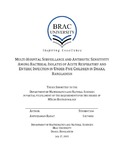| dc.contributor.advisor | Qadri, Firdausi | |
| dc.contributor.advisor | Choudhury, Naiyyum | |
| dc.contributor.author | Rahat, Asifuzzaman | |
| dc.date.accessioned | 2019-06-25T10:45:58Z | |
| dc.date.available | 2019-06-25T10:45:58Z | |
| dc.date.copyright | 2015 | |
| dc.date.issued | 2015-07-27 | |
| dc.identifier.other | ID 13276002 | |
| dc.identifier.uri | http://hdl.handle.net/10361/12258 | |
| dc.description | This thesis report is submitted in partial fulfilment of the requirement for the degree of Master of Science in Biotechnology, 2015. | en_US |
| dc.description | Catalogued from PDF version of thesis report. | |
| dc.description | Includes bibliographical references (pages 101-111). | |
| dc.description.abstract | Acute lower respiratory tract infection (ARI), enteric fever and diarrhea remain the
prevalent causes for mortality and morbidity of under-five children in Bangladesh.
However, little information is available on true prevalence of the pathogens responsible
for these diseases in under-five of Bangladesh and their susceptibility to antibiotics. In
this work, we evaluated the bacterial causes of infection in children seeking care in two
hospitals in Dhaka. This study utilized specimens collected as part of routine diagnostic
purpose encompassing, nasal swab for ARI, stool for diarrhea, and blood for enteric
fever. For isolation of the bacterial pathogens, conventional microbiological culture
methods were used, followed by detection using appropriate biochemical and
serological tests. For enteric fever, an additional immunological detection of Salmonella
Typhi and Paratyphi specific IgA immune response in lymphocyte secretions by
Typhoid-Paratyphoid Test (TPTest) was done and results compared with that of blood
culture. For diarrheal samples, ETEC isolates were tested for specific toxins using
multiplex PCR. Antibiotic susceptibility tests were performed according to the Clinical
and Laboratory Standard Institute (CLSI) guidelines. Of 100 ARI samples analyzed, 30
bacteria of different species were isolated, of which S. pneumoniae (50%) and K.
pneumoniae (26.7%) were the most prevalent. The overall antibiotic sensitivity test of
the isolates showed Meropenem, Impenem, Ceftriaxone, Ciprofloxacin, Penicillin and
Ampicillin as the most potent antibiotic against respiratory isolates. Of 47 samples
tested for enteric fever, 1 (2.1%) was culture positive for Salmonella Typhi, while 23
(49%) were TPTest positive. The S. Typhi isolate was only resistant to Nalidixic acid. 5 of
17 (29.4%) diarrheal samples were culture positive, 3 of which were identified as ETEC
and the other two V. cholerae, and Shigella dysenteriae respectively. The findings from
this study elucidate the major aetiologies causing infection in under-five children in
Dhaka. The antimicrobial sensitivity pattern of the relevant pathogens unraveled will
help guide physicians to prescribe appropriate antibiotics in settings where diagnostic
facilities are limited or not available. | en_US |
| dc.description.statementofresponsibility | Asifuzzaman Rahat | |
| dc.format.extent | 111 pages | |
| dc.language.iso | en | en_US |
| dc.publisher | BRAC University | en_US |
| dc.rights | BRAC University theses are protected by copyright. They may be viewed from this source for any purpose, but reproduction or distribution in any format is prohibited without written permission. | |
| dc.subject | Antibiotic sensivity | en_US |
| dc.subject | Acute lower respiratory tract infection (ARI) | en_US |
| dc.subject | Multi-hospital surveillance | en_US |
| dc.subject.lcsh | Respiratory therapy. | |
| dc.subject.lcsh | Respiratory infections--Prevention. | |
| dc.title | Multi-hospital surveillance and antibiotic sensitivity among bacterial isolates of acute respiratory and enteric infection in underfive children in Dhaka, Bangladesh | en_US |
| dc.type | Thesis | en_US |
| dc.contributor.department | Department of Mathematics and Natural Sciences, BRAC University | |
| dc.description.degree | M. Biotechnology | |

